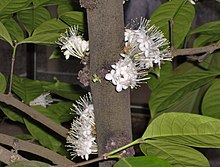Phaleria
| Phaleria | |
|---|---|

| |
| Phaleria capitata | |
| Scientific classification | |
| Kingdom: | Plantae |
| Clade: | Tracheophytes |
| Clade: | Angiosperms |
| Clade: | Eudicots |
| Clade: | Rosids |
| Order: | Malvales |
| Family: | Thymelaeaceae |
| Subfamily: | Thymelaeoideae |
| Genus: | Phaleria Jack (1822)[1] |
| Synonyms[2] | |
| |
Phaleria is flowering plant genus of about 25[3] species in the family Thymelaeaceae,[1] which range from Sri Lanka to Malesia, Papuasia, northern and eastern Australia, and the tropical Pacific Islands.[2]
Uses
[edit]Some species, like the mahkota dewa are known to produce agarwood.[4] Many others have long histories of use in traditional medicine like delal a kar (which translates to "the mother of medicines") which is used as a panacea by Palauans.[5]
Species
[edit]25 species are accepted.[2]
- Phaleria acuminata (A. Gray) Gilg — Fiji, American Samoa, Tonga, Western Samoa
- Phaleria angustifolia A. C. Sm. — Fiji
- Phaleria biflora (C.T.White) Herber – Qld, Australia endemic
- Phaleria capitata Jack – salagong-gubat (Sri Lanka, Palau, Malaysia, Sumatra, Borneo, Java, Philippines, Sulawesi, Moluccas, New Guinea)
- Phaleria chermsideana (F.M.Bailey) C.T.White – Qld, NSW, Australia
- Phaleria clerodendron (F.Muell.) Benth. – scented daphne (Qld, Australia)
- Phaleria coccinea (Gaudich.) F.Muell. – New Guinea, New Britain, Moluccas, Philippines
- Phaleria disperma (G.Forst) Baill. – Fiji, Niue, Samoa, Tonga, Wallis and Futuna
- Phaleria elegans L.M.Perry – New Guinea endemic
- Phaleria glabra (Turrill) Domke — Fiji, Tonga
- Phaleria ixoroides Fosberg — Fiji
- Phaleria lanceolata (A. Gray) Gilg — Fiji
- Phaleria longituba P. F. Stevens — New Guinea
- Phaleria macrocarpa (Scheff.) Boerl. (Syn.: P. papuana) – mahkota dewa (New Guinea, NT, Australia)
- Phaleria montana (Seem.) Gilg — Fiji
- Phaleria nisidae Kanehira — delal a kar (Palau, New Britain, New Guinea)
- Phaleria octandra (L.) Baill. – dwarf phaleria (New Guinea, Moluccas, Lesser Sunda Islands (Timor, Flores, Lombok, Bali, etc.), Java, NT, Qld, Australia)
- Phaleria okapensis P. F. Stevens — New Guinea (Papua)
- Phaleria pentecostalis Leandri — Vanuatu
- Phaleria perrottetiana (Decne.) Fern.-Vill. – New Guinea, Moluccas, Borneo, Philippines
- Phaleria pilistyla P. F. Stevens — New Guinea (Papua)
- Phaleria pubiflora (A. Gray) Gilg — Fiji
- Phaleria pulchra Gillespie — Fiji
- Phaleria sogerensis S.Moore – New Guinea
- Phaleria stevensiana Z. S. Rogers — Sulawesi
Taxonomy and phylogeny
[edit]Phylogenetic analysis shows that Phaleria's closest related genus is Dais, both of which are members of the Thymelaeoideae subfamily of the Thymelaeaceae family which contains 941 species in 48 different genera according to the Catalogue of Life.[3] The next closest related genera is a clade containing Gnidia, Stephanodaphne, Dirca, Ovidia, Peddiea, Pimelea, Struthiola, Lachnaea, Passerina, and Passerina.
References
[edit]- ^ a b "Phaleria Jack". Australian Plant Name Index (APNI), IBIS database. Centre for Plant Biodiversity Research, Australian Government. Retrieved 11 Nov 2013.
- ^ a b c "Phaleria Jack". Plants of the World Online. Royal Botanic Gardens, Kew. Retrieved 16 September 2024.
- ^ a b "Phaleria Jack". Catalogue of Life. Retrieved 5 Oct 2021.
- ^
Yih Lee; Turjaman; Mohamed1 (2018). "Phylogenetic Relatedness of Several Agarwood-Producing Taxa (Thymelaeaceae) from Indonesia". Tropical Life Sciences Research. 29 (2): 13–28. doi:10.21315/tlsr2018.29.2.2. PMC 6072731. PMID 30112138.
{{cite journal}}: CS1 maint: numeric names: authors list (link) - ^ Kulakowski, D.; Kitalong, C.; Negrin, A.; Tadao, V. R.; Balick, M. J.; Kennelly, E. J. (2015). "Traditional preparation of Phaleria nisidai, a Palauan tea, reduces exposure to toxic daphnane-type diterpene esters while maintaining immunomodulatory activity". Journal of Ethnopharmacology. 173: 273–279. doi:10.1016/j.jep.2015.06.023. PMID 26102551.
